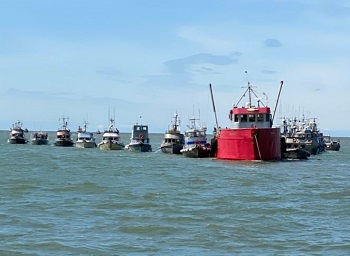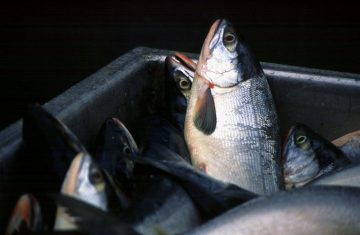Tag Archives: commercial salmon harvests
Copper River continues lead in PWS commercial salmon harvests
 With ice essentially gone from river systems, the sockeyes continued to weigh in heavier than through the same period a year ago, said fisheries biologist Jeremy Botz, in the Cordova office of the Alaska Department of Fish and Game. The Bering River and Coghill districts were also open for 36-hour commercial runs on Monday, and the Eshamy district for a 24-hour period. Montague District opened for purse seiners for 24 hours, and the Southwestern district for 48 hours, also for seiners. Even with other wild Alaska salmon fisheries opening for the season, Copper River sockeyes were holding their own in Anchorage restaurants, with entrees of Copper River reds offered at $49 at Simon and Seafort’s and $32 for the entree at Orso. more, >>CLICK TO READ<< 06:50
With ice essentially gone from river systems, the sockeyes continued to weigh in heavier than through the same period a year ago, said fisheries biologist Jeremy Botz, in the Cordova office of the Alaska Department of Fish and Game. The Bering River and Coghill districts were also open for 36-hour commercial runs on Monday, and the Eshamy district for a 24-hour period. Montague District opened for purse seiners for 24 hours, and the Southwestern district for 48 hours, also for seiners. Even with other wild Alaska salmon fisheries opening for the season, Copper River sockeyes were holding their own in Anchorage restaurants, with entrees of Copper River reds offered at $49 at Simon and Seafort’s and $32 for the entree at Orso. more, >>CLICK TO READ<< 06:50

Prince William Sound catch jumps to 35.7M fish
Commercial harvests in Prince William Sound have reached over 35.7 million fish, including nearly 32 million pink salmon, up by over 5 million fish from a week earlier, according to the state’s latest preliminary commercial harvest reports. As of Wednesday, Aug. 4, that report showed harvesters delivering to processors in Prince William Sound 31.9 million pink salmon, 2.5 million chums, 1.3 million sockeye, 11,000 cohos and 7,000 Chinooks. The biggest overall contributor to the harvest to date is the Prince William Sound general seine fishery, >click to read< 09:12

The big bust
The 2020 decline in North Pacific salmon numbers appears to have been the greatest in recorded history, according to a trio of scientists who’ve spent much of their careers studying the secret lives of salmon in the ocean. They suggested to the North Pacific Anadromous Fish Commission (NPAFC), an international monitoring group, that the crash was likely driven by warmer ocean waters and an explosion of pink salmon in 2018 and 2019.,, “Unexpectedly, the high abundance of Pacific salmon came to an abrupt end in 2020. Preliminary commercial catch statistics for all salmon species indicate Pacific salmon harvests, which provide an index of abundance, declined more in 2020 than in any other period on record since 1930. >click to read< 11:01

2020 commercial salmon catch, and value took a dive
Commercial salmon harvests proved challenging for the 2020 season, challenged by a global pandemic of the novel coronavirus, with the overall fish catch and its value down considerably from a year earlier. Data released on Monday, Nov. 9 by the Alaska Department of Fish and Game, said the all species harvest has an approximate value of $295.2 million, down 56 percent from $673.4 million in 2019. Fishermen delivered some 116.8 million fish, a 44 percent drop from the 208.3 harvested a year earlier, the report said. >click to read< 18:15

Slow going toward the 39M harvest forecast
Commercial salmon harvests in Prince William Sound topped the 15.4 million mark through July 31, up by three million fish over the previous week, compared to 20.4 million delivered by the same time a year ago. All five species of Pacific salmon are running below the catch rate or the same statistics week one year ago. The pink salmon harvest has reached nearly 11 million fish, compared to 13 million at this time in July of 2016, and this year’s forecast of 32.7 million humpies. Deliveries of sockeyes have reached 1.3 million fish, compared to a year-to-date harvest in 2017 of 1.4 million, and the keta harvest stood at 3.2 million fish, compared to a catch of 5.4 million chums through the same time last year. On the bright side, the Copper River district >click to read<13:47

Alaska: Prices are up, but commercial salmon harvests and forecasts are down
As a number of commercial salmon fisheries around the state kick off this week, the outlook for ex-vessel prices is looking good. Fishing economists say between lower run forecasts and strong foreign and domestic demand, commercial fishermen will likely see higher prices this year. But that doesn’t necessarily mean commercial fishermen will earn more this season compared to last year. Andy Wink with Wink Research and Consulting said although prices vary by species and region, most fisheries should see stable or higher prices this year. >click to read<08:20














































